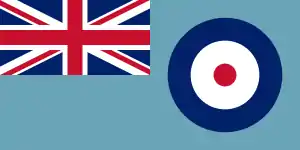No. 228 Squadron RAF
No. 228 Squadron RAF was a squadron of the Royal Air Force active at various times between 1918 and 1964. It spent the greatest part of its existence flying over water, doing so in First, and Second World Wars and beyond, performing anti-submarine, reconnaissance and air-sea rescue tasks.
| No. 228 Squadron RAF | |
|---|---|
| Active | 20 Aug 1918 - 30 Jun 1919 15 Dec 1936 – 4 Jun 1945 1 Jun 1946 - 30 Sep 1946 1 Jul 1954 - 6 Mar 1959 1 Sep 1959 – 28 Aug 1964 |
| Country | |
| Branch | |
| Role | anti-submarine, reconnaissance and air-sea rescue |
| Motto(s) | Latin: Auxilium a caelo (Translation: "Help from the sky")[1][2] |
| Insignia | |
| Squadron Badge heraldry | A winged helmet[1][2] |
| Squadron Codes | TO (Apr 1939 - May 1939) BH (May 1939 - Sep 1939) DQ (Sep 1939 - Aug 1943) UE (Jul 1944 - Jun 1945) L (Jul 1954 - 1956) 228 (1956 - May 1959) |
History
Formation and the First World War

The squadron formed on 20 August 1918 at Great Yarmouth during the re-organisation of the former RNAS stations of Nos. 324, 325 and 326 Flights.[1] The squadron was initially equipped with both Felixstowe F.2A and Curtiss H.16 aircraft and was involved in anti-submarine patrols. The last patrol was flown on 24 October 1918 and the squadron disbanded on 30 June 1919 at RNAS Killingholme.[1][2]
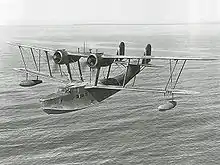
Reformation
The squadron reformed on 15 December 1936 at RAF Pembroke Dock, and was initially equipped with a variety of aircraft including Short Singapores, a Supermarine Scapa, a Saro London and a Supermarine Stranraer.[2] However, by September 1938 the squadron was just operating Stranraers.[3][4] In November 1938 the squadron received its first Short Sunderland, and by April 1939 the squadron was completely re-equipped with Sunderlands.[3][4]
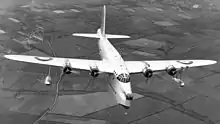
Second World War
When the Second World War began the squadron was at Alexandria in Egypt. The squadron immediately returned to Pembroke Dock and sent detachments to RAF Invergordon and RAF Sullom Voe. In June 1940 the squadron returned to Egypt following Italy's declaration of war on Britain. In June 1941 the squadron moved to Gambia, West Africa, returning in August 1941 to Pembroke Dock and then RAF Stranraer to be re-equipped. In March 1942 at RAF Oban, the squadron became operational again, moving to RAF Lough Erne in December 1942 and then back to Pembroke Dock in May 1943, where it remained until disbanding on 4 June 1945.[3][4]
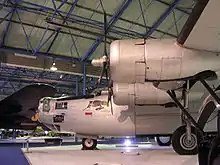
On Liberators
On 1 June 1946 the squadron reformed at RAF St Eval when No. 224Y Squadron was renumbered. The squadron was equipped with Consolidated Liberators GR.6 and GR.8s and performed passenger and freight services with the Liberators to Ireland, Gibraltar, the Azores and Morocco, but also had reconnaissance, air-sea rescue and meteorological tasks. It disbanded on 30 September 1946 at RAF St Eval.[1][4]
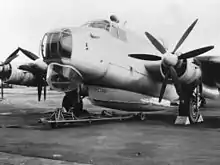
On Shackletons
The squadron reformed again on 1 July 1954 at St Eval, equipped with the Avro Shackleton as a maritime reconnaissance unit, moving in November 1956 to RAF St Mawgan and in January 1958 back to St Eval, where is disbanded on 1 April 1959.[1][4]
On Helicopters
In September 1959 the squadron reformed again via the renumbering of No. 275 Squadron at RAF Leconfield. The squadron was now a helicopter search and rescue unit, flying Bristol Sycamores -passing them on to 118 sqn- and Westland Whirlwinds.
On 28 August 1964 the squadron was disbanded at Leconfield, when it was renumbered to No. 202 Squadron.[1][4]
Aircraft operated


| From | To | Aircraft | Version |
|---|---|---|---|
| August 1918 | April 1919 | Felixstowe F.2 | a |
| August 1918 | March 1919 | Curtiss Model H | 16 |
| February 1937 | August 1938 | Supermarine Scapa | |
| February 1937 | September 1938 | Saro London | Mk.I |
| April 1937 | September 1937 | Short Singapore | Mk.III |
| April 1937 | April 1939 1937 | Supermarine Stranraer | |
| November 1938 | August 1941 | Short Sunderland | Mk.I |
| November 1941 | March 1943 | Short Sunderland | Mk.I |
| November 1941 | March 1943 | Short Sunderland | Mk.II |
| March 1942 | April 1945 | Short Sunderland | Mk.III |
| February 1945 | June 1945 | Short Sunderland | Mk.V |
| June 1946 | September 1946 | Consolidated Liberator | Mk.VIII |
| July 1954 | March 1959 | Avro Shackleton | MR.2 |
| September 1959 | March 1960 | Avro Anson | T.21 |
| September 1959 | June 1960 | Bristol Sycamore | HR.14 |
| September 1959 | December 1962 | Westland Whirlwind | HAR.2 |
| September 1959 | December 1962 | Westland Whirlwind | HAR.4 |
| September 1962 | August 1964 | Westland Whirlwind | HAR.10 |
Squadron airfields
| From | To | Base | Remark |
|---|---|---|---|
| 20 August 1918 | 30 April 1919 | RAF Great Yarmouth, Norfolk | |
| 30 April 1919 | 5 June 1919 | RAF Brough, East Riding of Yorkshire | |
| 5 June 1919 | 30 June 1919 | RAF Killingholme, Lincolnshire | |
| 15 December 1936 | 29 September 1938 | RAF Pembroke Dock, Pembrokeshire, Wales | |
| 29 September 1938 | 9 October 1938 | RAF Invergordon, Ross and Cromarty, Scotland | |
| 9 October 1938 | 5 June 1939 | RAF Pembroke Dock, Pembrokeshire, Wales | |
| 5 June 1939 | 10 September 1939 | RAF Alexandria, Egypt | |
| 10 September 1939 | 10 June 1940 | RAF Pembroke Dock, Pembrokeshire, Wales | |
| 10 June 1940 | 19 July 1940 | RAF Alexandria, Egypt | Detachment at RAF Kalafrana, Malta |
| 19 July 1940 | 13 September 1940 | RAF Aboukir, Egypt | Detachment at RAF Kalafrana, Malta |
| 13 September 1940 | 25 March 1941 | RAF Kalafrana, Malta | Detachment at RAF Alexandria, Egypt |
| 25 March 1941 | 16 June 1941 | RAF Alexandria, Egypt | |
| 16 June 1941 | 28 August 1941 | En route to West Africa | |
| 28 August 1941 | 26 September 1941 | RAF Bathurst, Gambia | |
| 26 September 1941 | 9 October 1941 | En route to UK | |
| 9 October 1941 | 10 March 1942 | RAF Stranraer, Wigtownshire, Scotland | re-established here |
| 10 March 1942 | 11 December 1942 | RAF Oban, Argyll and Bute, Scotland | |
| 11 December 1942 | 4 May 1943 | RAF Castle Archdale, County Fermanagh, Northern Ireland | (Lough Erne) |
| 4 May 1943 | 4 June 1945 | RAF Pembroke Dock, Pembrokeshire, Wales | |
| 1 June 1946 | 30 September 1946 | RAF St Eval, Cornwall | |
| 1 July 1954 | 29 November 1956 | RAF St Eval, Cornwall | |
| 29 November 1956 | 14 January 1958 | RAF St Mawgan, Cornwall | |
| 14 January 1958 | 6 March 1959 | RAF St Eval, Cornwall | |
| 1 September 1959 | 28 August 1964 | RAF Leconfield, Yorkshire | Dets. at RAF Acklington, Northumberland; RAF Leuchars, Fife, Scotland; RAF Horsham St Faith, Norfolk and RAF Coltishall, Norfolk |
Notes
- Halley 1988, p. 294.
- Rawlings 1982, p. 154.
- Halley 1988, pp. 294-295.
- Jefford 2001, p. 76.
References
- Bowyer, Michael J.F. and John D.R. Rawlings. Squadron Codes, 1937-56. Cambridge, UK: Patrick Stephens Ltd., 1979. ISBN 0-85059-364-6.
- Evans, John. Help from the Heavens: A History of No. 228 Squadron RAF. Pembroke Dock, Pembrokeshire, UK: Paterchurch Publications, 1998. ISBN 1-870745-06-X.
- Flintham, Vic and Andrew Thomas. Combat Codes: A full explanation and listing of British, Commonwealth and Allied air force unit codes since 1938. Shrewsbury, Shropshire, UK: Airlife Publishing Ltd., 2003. ISBN 1-84037-281-8.
- Halley, James J. The Squadrons of the Royal Air Force & Commonwealth 1918-1988. Tonbridge, Kent, UK: Air Britain (Historians) Ltd., 1988. ISBN 0-85130-164-9.
- Jefford, C.G. RAF Squadrons, a Comprehensive Record of the Movement and Equipment of all RAF Squadrons and their Antecedents since 1912. Shrewsbury, Shropshire, UK: Airlife Publishing, 2001. ISBN 1-84037-141-2.
- Rawlings, John D.R. Coastal, Support and Special Squadrons of the RAF and their Aircraft. London: Jane's Publishing Company Ltd., 1982. ISBN 0-7106-0187-5.
External links
| Wikimedia Commons has media related to No. 228 Squadron RAF. |
